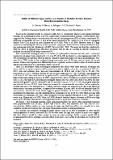Por favor, use este identificador para citar o enlazar a este item:
http://hdl.handle.net/10261/102282COMPARTIR / EXPORTAR:
 SHARE
BASE SHARE
BASE
|
|
| Visualizar otros formatos: MARC | Dublin Core | RDF | ORE | MODS | METS | DIDL | DATACITE | |

| Título: | Ability of different types and doses of tannins to modulate in vitro ruminal biohydrogenation in sheep |
Autor: | Carreño Yugueros, David CSIC ORCID; Hervás, Gonzalo CSIC ORCID ; Belenguer, Álvaro CSIC ORCID ; Toral, Pablo G. CSIC ORCID ; Frutos, Pilar CSIC ORCID | Palabras clave: | Tannins Biohydrogenation Ewe |
Fecha de publicación: | sep-2014 | Editor: | Australian Society of Animal Production | Citación: | 30 th Biennial Conference of the Australian Society of Animal Production: 157 (2014) First Joint International Symposium on the Nutrition of Herbivores/International Symposium on Ruminant Physiology (ISNH/ISRP) |
Resumen: | Based on the potential benefits to consumer health, there is considerable interest in developing nutritional
strategies for modulating the fatty acid (FA) composition of ruminant-derived products. Several reports have
suggested that feeding tannins can favourably alter ruminal biohydrogenation (BH) of dietary unsaturated FA,
enhancing accumulation of trans-11 18:1 in the rumen and thereby the content of cis-9 trans-11 conjugated
linoleic acid (CLA) in milk or meat (Khiaosa-ard et al 2009, Vasta et al 2009). However, there is a large
controversy surrounding the efficacy of these phenolic compounds, which has been mainly attributed to their
type and amount in the diet (Kronberg et al 2007, Toral et al 2011, 2013). This assay was therefore conducted to
study the effect of different types and doses of tannins with the aim of selecting an effective treatment to
modulate the ruminal BH of dietary unsaturated FA.
Four commercial oenological extracts of tannins [2 hydrolysable (chestnut and oak) and 2 condensed
(quebracho and grape)] were added (at 0, 2, 4, 6 or 8% of the DM incubated) to a diet supplemented with 2%
DM of sunflower oil, and their effect on BH was examined using batch cultures of rumen microorganisms. Five
ewes fed a TMR similar to that incubated (forage:concentrate ratio 50:50) were used as donors of ruminal
inocula. Cultures were repeated on 3 different days (run = replicate), and freeze dried residues of in vitro ruminal
digesta were analysed for FA composition (Toral et al 2012).
After 12 h incubations (when, according to preliminary data, effects were better detected), all tannins and
doses, with the exception of quebracho8%, proved to be able to slightly reduce the concentration of 18:0 (P <
0.05). Low and moderate doses increased concentrations of 18:2n-6 and 18:3n-3 (up to 90 and 71%,
respectively; P < 0.01). However, only the 6% and 8% doses augmented cis-9 18:1. Likewise, concentrations of
cis-9 trans-11 18:2 were only favoured by quebracho6%, chestnut6%, grape8% and oak8% (P < 0.001), the
highest value representing an increase of 128% compared to the control. A tendency to a greater accumulation of
trans-11 18:1, the target FA in the rumen according to Khiaosa-ard et al (2009) and Vasta et al (2009), was only
detected with grape6% and 8%, chestnut6% and 8%, and oak2% (up to 15.5%; P < 0.10). An irregular behaviour
was observed for trans-10 18:1: some treatments increased its concentration but some others, such as quebracho,
chestnut and oak at 2%, decreased it (P < 0.001). All these changes are supposed to be due to the effects of
tannin extracts on rumen microbiota, as supported by variations, in many cases, in odd and branched-chain FA
concentrations. Overall, the results would suggest a general inhibition of the rumen microbial BH of dietary
unsaturated FA rather than a specific inhibition of the conversion of trans-11 18:1 to 18:0, which is in line with
observations by Kronberg et al (2007) when trying to lessen the ruminal reduction of 18:3n-3. Other in vitro
assays (e.g., Khiaosa-ard et al 2009, Vasta et al 2009) showed a beneficial impact of tannins on BH at very high
doses (up to 18% DM). Nevertheless, such high levels would be impractical under farm conditions. The tannin × dose treatment showing a more promising behaviour was oak2%. This combination increased total polyunsaturated FA, 18:3n-3, 18:2n-6 and trans-11 18:1, and decreased 18:0 and trans-10 18:1 concentrations. Further studies are now necessary to make sure that these effects are extended to in vivo conditions and that the treatment does not impair ruminal fermentation or animal performance. To conclude, the examined oenological tannin extracts seem to be able to modulate in vitro ruminal biohydrogenation of dietary unsaturated FA. On the other hand, the high dose required in most cases suggests that their efficacy would be rather limited in terms of animal feeding. Further research would still be recommended for extracts exerting a desirable effect at low doses, such as that of oak tannins at 2% of the DM incubated. |
Descripción: | 1 página.-- Comunicación presentada al 30th Biennial Conference of the Australian Society of Animal Production y al First Joint International Symposium on the Nutrition of Herbivores/International Symposium on Ruminant Physiology (ISNH/ISRP) (Canberra, Australia, 8-12 de septiembre del 2014). | URI: | http://hdl.handle.net/10261/102282 | ISSN: | 0728-5965 |
| Aparece en las colecciones: | (IGM) Comunicaciones congresos |
Ficheros en este ítem:
| Fichero | Descripción | Tamaño | Formato | |
|---|---|---|---|---|
| Carreño et al_2014_Tannins and BH (ISNH-ISRP).pdf | 739,27 kB | Adobe PDF |  Visualizar/Abrir |
CORE Recommender
Page view(s)
375
checked on 16-abr-2024
Download(s)
117
checked on 16-abr-2024
Google ScholarTM
Check
NOTA: Los ítems de Digital.CSIC están protegidos por copyright, con todos los derechos reservados, a menos que se indique lo contrario.
